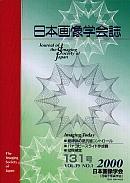Volume 50, Issue 5
Displaying 1-11 of 11 articles from this issue
- |<
- <
- 1
- >
- >|
Original Paper
-
2011 Volume 50 Issue 5 Pages 404-409
Published: October 10, 2011
Released on J-STAGE: October 13, 2011
Download PDF (541K)
Quick Report
-
2011 Volume 50 Issue 5 Pages 410-414
Published: October 10, 2011
Released on J-STAGE: October 13, 2011
Download PDF (421K)
Review
-
2011 Volume 50 Issue 5 Pages 415-421
Published: October 10, 2011
Released on J-STAGE: October 13, 2011
Download PDF (1043K)
Imaging Today
-
2011 Volume 50 Issue 5 Pages 423-431
Published: October 10, 2011
Released on J-STAGE: October 13, 2011
Download PDF (1941K) -
2011 Volume 50 Issue 5 Pages 432-438
Published: October 10, 2011
Released on J-STAGE: October 13, 2011
Download PDF (986K) -
2011 Volume 50 Issue 5 Pages 439-447
Published: October 10, 2011
Released on J-STAGE: October 13, 2011
Download PDF (2478K) -
2011 Volume 50 Issue 5 Pages 448-454
Published: October 10, 2011
Released on J-STAGE: October 13, 2011
Download PDF (830K) -
2011 Volume 50 Issue 5 Pages 455-462
Published: October 10, 2011
Released on J-STAGE: October 13, 2011
Download PDF (827K) -
2011 Volume 50 Issue 5 Pages 463-469
Published: October 10, 2011
Released on J-STAGE: October 13, 2011
Download PDF (634K) -
2011 Volume 50 Issue 5 Pages 470-474
Published: October 10, 2011
Released on J-STAGE: October 13, 2011
Download PDF (900K)
Lectures in Science
-
2011 Volume 50 Issue 5 Pages 475-482
Published: October 10, 2011
Released on J-STAGE: October 13, 2011
Download PDF (926K)
- |<
- <
- 1
- >
- >|
